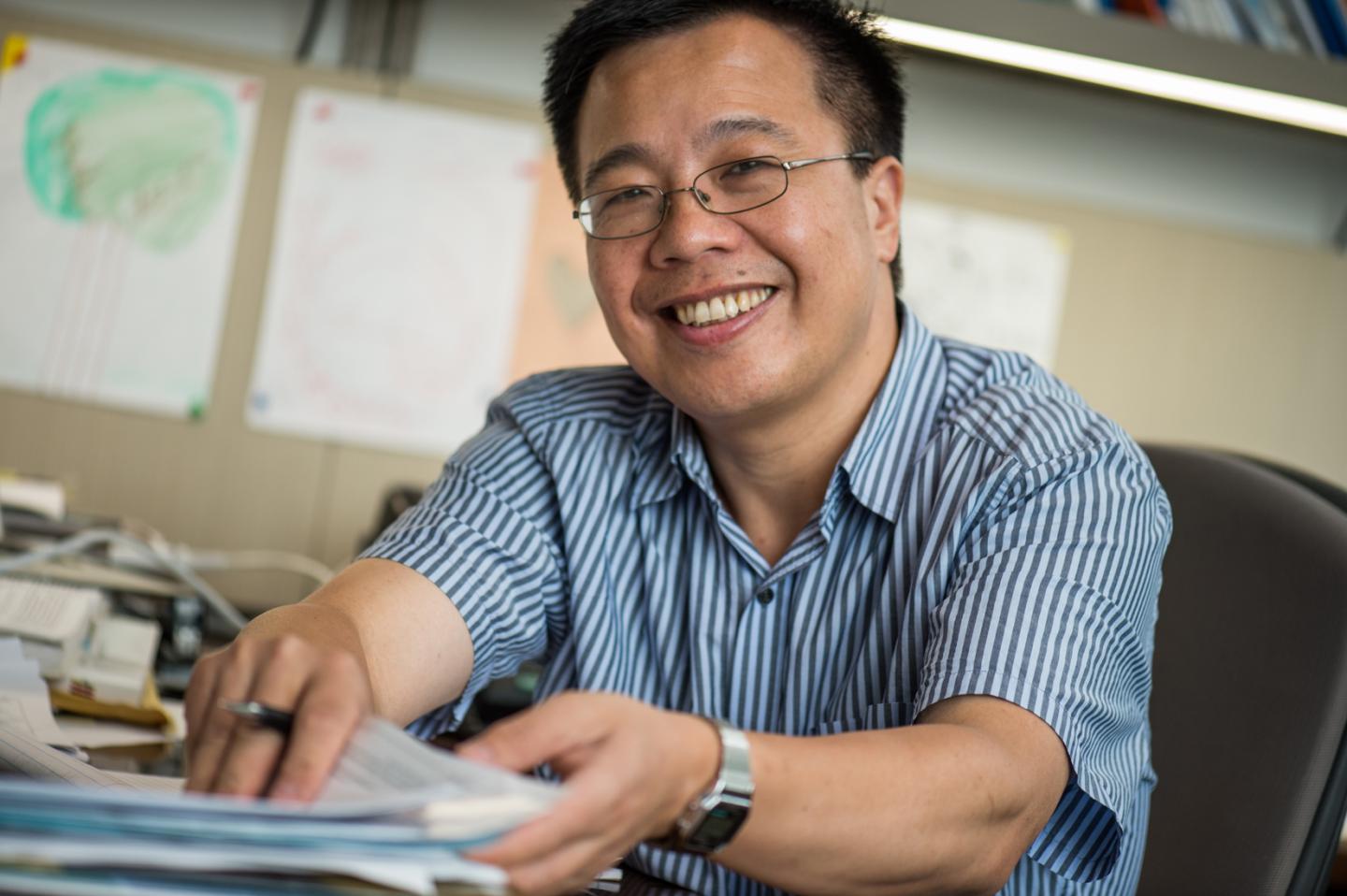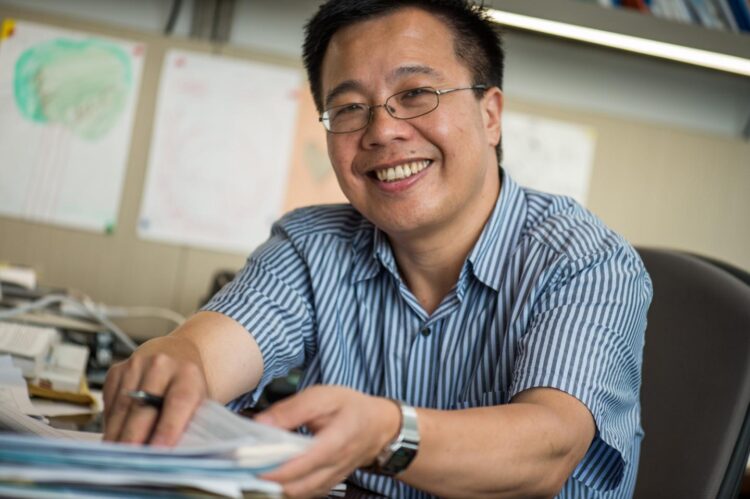Commonly mistaken name leads to broader discovery by Rice, Arizona State physicists

Credit: Photo by Jeff Fitlow/Rice University
HOUSTON – (Jan. 25, 2021) – A new theory that could explain how unconventional superconductivity arises in a diverse set of compounds might never have happened if physicists Qimiao Si and Emilian Nica had chosen a different name for their 2017 model of orbital-selective superconductivity.
In a study published this month in npj Quantum Materials, Si of Rice University and Nica of Arizona State University argue that unconventional superconductivity in some iron-based and heavy-fermion materials arises from a general phenomenon called “multiorbital singlet pairing.”
In superconductors, electrons form pairs and flow without resistance. Physicists cannot fully explain how pairs form in unconventional superconductors, where quantum forces give rise to strange behavior. Heavy fermions, another quantum material, feature electrons that appear to be thousands of times more massive than ordinary electrons.
Si and Nica proposed the idea of selective pairing within atomic orbitals in 2017 to explain unconventional superconductivity in alkaline iron selenides. The following year, they applied the orbital-selective model to the heavy fermion material in which unconventional superconductivity was first demonstrated in 1979.
They considered naming the model after a related mathematical expression made famous by quantum pioneer Wolfgang Pauli, but opted to call it d+d. The name refers to mathematical wave functions that describe quantum states.
“It’s like you have a pair of electrons that dance with each other,” said Si, Rice’s Harry C. and Olga K. Wiess Professor of Physics and Astronomy. “You can characterize that dance by s- wave, p-wave and d-wave channels, and d+d refers to two different kinds of d-waves that fuse together into one.”
In the year after publishing the d+d model, Si gave many lectures about the work and found audience members frequently got the name confused with “d+id,” the name of another pairing state that physicists have discussed for more than a quarter century.
“People would approach me after a lecture and say, ‘Your theory of d+id is really interesting,’ and they meant it as a compliment, but it happened so often it got annoying,” said Si, who also directs the Rice Center for Quantum Materials (RCQM).
In mid-2019, Si and Nica met over lunch while visiting Los Alamos National Laboratory, and began sharing stories about the d+d versus d+id confusion.
“That led to a discussion of whether d+d might be connected with d+id in a meaningful way, and we realized it was not a joke,” Nica said.
The connection involved d+d pairing states and those made famous by the Nobel Prize-winning discovery of helium-3 superfluidity.
“There are two types of superfluid pairing states of liquid helium-3, one called the B phase and the other the A phase,” Nica said. “Empirically, the B phase is similar to our d+d, while the A phase is almost like a d+id.”
The analogy got more intriguing when they discussed mathematics. Physicists use matrix calculations to describe quantum pairing states in helium-3, and that is also the case for the d+d model.
“You have a number of different ways of organizing that matrix, and we realized our d+d matrix for the orbital space was like a different form of the d+id matrix that describes helium-3 pairing in spin space,” Nica said.
Si said the associations with superfluid helium-3 pairing states have helped he and Nica advance a more complete description of pairing states in both iron-based and heavy-fermion superconductors.
“As Emil and I talked more, we realized the periodic table for superconducting pairing was incomplete,” Si said, referring to the chart physicists use to organize superconducting pairing states.
“We use symmetries — like lattice or spin arrangements, or whether time moving forward versus backward is equivalent, which is time-reversal symmetry — to organize possible pairing states,” he said. “Our revelation was that d+id can be found in the existing list. You can use the periodic table to construct it. But d+d, you cannot. It’s beyond the periodic table, because the table doesn’t include orbitals.”
Si said orbitals are important for describing the behavior of materials like iron-based superconductors and heavy fermions, where “very strong electron-electron correlations play a crucial role.”
“Based on our work, the table needs to be expanded to include orbital indices,” Si said.
The research was supported by a startup grant from Arizona State University, the Department of Energy (DE-SC0018197), the Welch Foundation (C-1411) and the National Science Foundation (PHY-1607611).
RCQM is a multidisciplinary research effort that leverages the strengths and global partnerships of more than 20 Rice research groups.
###
Links and resources:
The DOI of the npj Quantum Materials paper is: 10.1038/s41535-020-00304-3
A copy of the paper is available at: https:/
Rice Center for Quantum Materials: https:/
High-resolution IMAGES are available for download at:
http://bit.
CAPTION: “Levitation of a magnet on top of a superconductor 2” by Jubobroff, Fbouquet, LPS is licensed under CC BY-SA 3.0.
http://news.
CAPTION: Qimiao Si is the Harry C. and Olga K. Wiess Professor of Physics and Astronomy at Rice University and director of the Rice Center for Quantum Materials. (Photo by Jeff Fitlow/Rice University)
https:/
CAPTION: Emilian Nica is a postdoctoral research scholar in physics at Arizona State University. (Image courtesy of E. Nica)
This release can be found online at news.rice.edu.
Follow Rice News and Media Relations via Twitter @RiceUNews.
Located on a 300-acre forested campus in Houston, Rice University is consistently ranked among the nation’s top 20 universities by U.S. News & World Report. Rice has highly respected schools of Architecture, Business, Continuing Studies, Engineering, Humanities, Music, Natural Sciences and Social Sciences and is home to the Baker Institute for Public Policy. With 3,978 undergraduates and 3,192 graduate students, Rice’s undergraduate student-to-faculty ratio is just under 6-to-1. Its residential college system builds close-knit communities and lifelong friendships, just one reason why Rice is ranked No. 1 for lots of race/class interaction and No. 1 for quality of life by the Princeton Review. Rice is also rated as a best value among private universities by Kiplinger’s Personal Finance.
Media Contact
Jade Boyd
[email protected]
Related Journal Article
http://dx.





